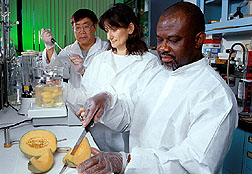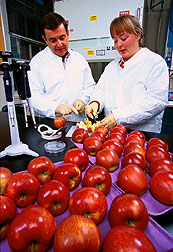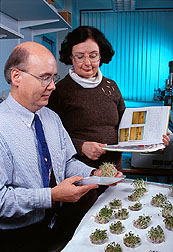Minimizing Microbes on Fresh-Cut Foods
Fruits and vegetables are vital to our health and well-being, providing essential vitamins, minerals, and fiber to our diet. But although U.S. consumers have one of the safest supplies of fresh produce in the world, new outbreaks of food poisoning linked to fruits and vegetables continue to occur.
These outbreaks come from produce grown both here at home and abroad. In the past few years, outbreaks of foodborne illness have been traced to E. coli O157:H7 and Salmonella found on lettuce, cantaloupe, and sprouts; Shigella on parsley and lettuce; and Cyclospora on raspberries.
"Concern about these outbreaks and their implications led the current administration to propose a research strategy that enhances the safety of fruits and vegetables," says James A. Lindsay. He is the primary leader of the ARS national research program directed toward the microbial safety of fruits and vegetables.
As part of his earlier National Food Safety Initiative, on October 2, 1997, President Clinton launched the Produce and Imported Foods Safety Initiative. Under this plan, USDA and other government agencies were charged with developing a research plan that would help minimize risks posed by microbial pathogens on fresh and minimally processed fruits and vegetables. Examples of minimally processed produce are bagged salads, melon balls, and many other peeled or sliced—but still uncooked—fruits and vegetables.
"Working with the Food and Drug Administration's (FDA) Center for Food Safety and Applied Nutrition, our new research plan focuses on reducing diseases caused by foodborne pathogens," Lindsay says. "Our first official response to the President's directive was to publish guidelines for U.S. industry that provide voluntary, science-based information for improving the safety of fresh produce as it moves from farm to table."
Titled "Guide to Minimize Microbial Food Safety Hazards for Fresh Fruit and Vegetables," the publication—which is not a government regulation—addresses microbial food safety hazards. It describes good agricultural and management practices for growing, harvesting, washing, sorting, packing, and transporting most fruits and vegetables sold to consumers in fresh or minimally processed form.
|
|
"Another focus of the Food Safety Initiative is to identify and support research priorities that will fill gaps in food safety knowledge," Lindsay notes. "We plan to conduct a risk assessment for produce and incorporate the information in a multiyear research plan."
Since 1997, ARS has increased research efforts to promote the safety of fruits and vegetables.
"We're concentrating our research at three different locations: Beltsville, Maryland; Wyndmoor, Pennsylvania; and Albany, California," Lindsay says. "This year alone, we allocated $6.6 million to eight research projects devoted to enhancing the safety of fruits and vegetables and have requested an additional $2.1 million for fiscal year 2000."
Understanding Microbial Miscreants
In Beltsville, Maryland, staffing is being increased, and positive research results have already been achieved at the ARS Horticultural Crops Quality Laboratory (HCQL).
"We're adding a microbiological safety team to our research unit," says HCQL leader Kenneth C. Gross. "It will include a microbiologist, along with a plant pathologist and a plant physiologist."
This team will help deal with a critical aspect of food safety: the physiological and biochemical factors involved in the interaction among foodborne pathogens, their fruit and vegetable hosts, and associated beneficial microbes, Gross reports.
In the lab, plant pathologist William S. Conway has already shown that the Listeria monocytogenes bacterium can grow on fresh-cut apple slices. And controlled-atmosphere storage had no effect on this bacterium's survival.
"Most consumers usually eat an apple whole," Gross says. "The apple peel serves as a barrier to many foodborne pathogens. But demand is growing for fresh-cut produce, a form that is open to potentially harmful microorganisms."
Cutting produce causes wounds that pave the way for pathogens to attack.
Gross and colleagues are studying relationships between these pathogens and naturally occurring, beneficial organisms. There is only so much room and food for organisms to exist on a given piece of produce—a case of survival of the strongest organism.
Food technologist Alley E. Watada at the HCQL lab found that spinach contains naturally occurring compounds and beneficial microorganisms that slow down the growth of Listeria. "It's important that these helpful organisms not be removed during sanitation treatments after harvest," Gross says.
HCQL scientists are also looking at the quality of fruits and vegetables. "We're continuing our work on ensuring that we start with the best quality possible," says Gross. This includes developing new lines of fruits and vegetables that store longer and resist pathogens better.
Commodities being studied at HCQL to bolster their microbial safety include fresh-cut spinach, celery, carrots, apples, bananas, sweet peppers, tomatoes, squash, strawberries, grapefruit, grapes, plums, and melons.
Fruit and vegetable contamination is a primary concern of food safety research at ARS' Eastern Regional Research Center (ERRC) in Wyndmoor, Pennsylvania.
"Our first priority is to eliminate the contamination, and we've been very successful with irradiation," says Donald W. Thayer, head of the Food Safety Research Unit. "Next year, we expect to have a commercial food irradiator installed in our center."
Thayer's found that pasteurizing food by irradiation significantly reduces the numbers of harmful microorganisms such as E. coli, Bacillus cereus, L. monocytogenes, Salmonella, and Staphylococcus aureus. Ionizing radiation is a safe and effective food preservation tool.
"We used the FDA-recommended dose of irradiation for fresh fruit on raspberries contaminated with Cyclospora," Thayer says. "Not only did we inactivate the parasite, we doubled the berries' shelf life as well."
Thayer and colleagues Kathleen T. Rajkowski and William F. Fett have successfully used irradiation and chlorine to kill E. coli O157:H7 and Salmonella on alfalfa seeds and sprouts.
Since 1995, raw alfalfa sprouts have been recognized as a source of foodborne illness in the United States, with several outbreaks of both E. coli O157:H7 and Salmonella. As a result, the FDA and the Centers for Disease Control and Prevention have advised those at high risk, namely children, the elderly, and persons with compromised immune systems, to avoid eating raw alfalfa sprouts.
Because of their fragility, sprouts cannot withstand abrasive physical washing. So the focus has been on cleaning the seeds, which are suspected as the source of the pathogens. U.S. sprout growers are looking for an effective, practical, and cost-effective way to ensure that sprouts are free of pathogenic organisms.
Microbiologists Rajkowski and Thayer used irradiation to treat alfalfa seeds and sprouts. "We used a dose approved for irradiating meat and controlled both Salmonella and E. coli O157:H7. The irradiation also extended the shelf life of sprouts from about 5 days to more than a week," Rajkowski reports.
Both E. coli and Salmonella were more resistant on dry seeds than on sprouts because of the lack of moisture in the seeds, although a higher dose of irradiation did kill both pathogens. According to Thayer, the dose level that eliminated E. coli had little effect on the germination of the irradiation-treated seeds. This may not be true for Salmonella, which needs a higher dose.
A Chemical Sanitizer
|
|
To decontaminate sprouts, Fett, a microbiologist in ERRC's Plant Science and Technology Unit, has been investigating an alternative treatment—chemical sanitation.
He subjected alfalfa seeds to 2-percent, 2.5-percent, and 3-percent weight-per-volume concentrations of calcium hypochlorite (a chlorine source). A 3-percent concentration means about 20,000 parts per million of available chlorine. At a neutral pH of about 7, Fett got a 99.99-percent reduction in E. coli O157:H7 for the 2.5 and 3 percent concentrations.
"The pH is important because at a higher pH level, such as 10, the chlorine would change to a form that would not be as effective in killing bacteria," Fett says.
"And sprouts may be contaminated internally, which would prevent a surface disinfectant from working effectively," Thayer adds. "Therefore, in practice, the best way to eliminate pathogens might be a combination of irradiation and sanitation treatments."
Food technologist Gerald M. Sapers, also in the Plant Science and Technology Research Unit, is working with colleagues Ching-Hsing Liao, Dike Ukuku, and Bassam Annous to study sanitizing of produce that has been contaminated with human pathogens. These include E. coli O157:H7, Salmonella, and Listeria monocytogenes.
This team is looking at apple cider and other fresh-apple products, as well as fresh-cut fruits and vegetables including melons and sprouts. Kevin B. Hicks, who heads the unit, says that they are identifying sources of contamination and examining the processes that limit the efficacy of produce washing.
"From these results, we hope to develop ways to prevent contamination, kill or remove microbial contaminants, or suppress their growth on fruits and vegetables," Hicks says.
"In collaboration with Pennsylvania State University, we're designing and building a one-of-a-kind fruit and vegetable processing research facility at ERRC. This facility will allow us to quickly develop methods to kill or remove bacteria from fresh fruits and vegetables in surroundings more reflective of an industrial setting," says Hicks.
We feel this is very important, since we've found that conventional processing equipment and commercial sanitizers don't seem to be very effective at removing bacteria from these commodities."
"We'll use commercial-scale conveying, washing, and processing equipment with our newly developed sanitizing treatments," Hicks says. "Our aim is to help meet the President's goal of developing cost-effective ways to reduce the incidence of foodborne illness associated with fresh and processed produce." — By Doris Stanley Lowe, Agricultural Research Service Information Staff.
This research is part of Food Safety, an ARS National Program described on the World Wide Web at http://www. nps.ars.usda.gov/programs/cppvs.htm.
James A. Lindsay is with the USDA-ARS National Program Staff, 5601 Sunnyside Ave., Beltsville, MD 20705-5138; phone (301) 504-4674, fax (301) 504-5467.
Kenneth C. Gross is at the USDA-ARS Horticultural Crops Quality Laboratory, Bldg. 002, 10300 Baltimore Ave., Beltsville, MD 20705-2350; phone (301) 504-6128, fax (301) 504-5107.
Donald W. Thayer is in the USDA-ARS Food Safety Research Unit, Eastern Regional Research Center, 600 East Mermaid Lane, Wyndmoor, PA 19038; phone (215) 233-6582, fax (215) 233-6406.
Kevin B. Hicks is in the USDA-ARS Plant Science and Technology Unit, Eastern Regional Research Center, 600 East Mermaid Lane, Wyndmoor, PA 19038; phone (215) 233-6580, fax (215) 233-6406.
"Minimizing Microbes on Fresh-Cut Foods" was published in the June 1999 issue of Agricultural Research magazine.









